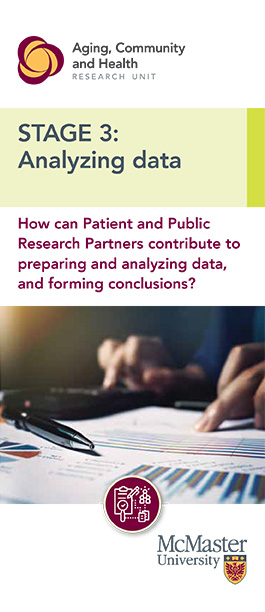How can Patient and Public Research Partners contribute to preparing and analyzing data, and forming conclusions?
What is data analysis?
Data analysis can be split into two steps: discovering useful information and forming conclusions.
Step I. Discovering useful information
To prepare for analysis:
• Qualitative data needs to be converted into written text
• Quantitative data needs to be entered into computer software.
Then data analysis can begin. The approach to analysis depends on whether the data is qualitative or quantitative.
| Qualitative
|
| Examples of data: Interview transcripts, journal notes, written answers to questions, captions on photos.
|
| Examples of analysis: Search for and record ideas that come up repeatedly in the text. These form themes. |
| Quantitative |
| Examples of data: Survey response scores on a numbered scale, costs of an old and new way of delivering care, how often services are used, characteristics of participants such as age, income. |
| Examples of analysis: Calculate the average age and compare by sex. |
When it comes to numeric data, researchers often work with statisticians to help with analysis.
Step II. Forming conclusions
The next step is to figure out the most important messages resulting from the analysis.
These messages often inform recommendations, for example changes needed in health and social care delivery, or future research.
How can you help?
Patient and Public Research partners can help in many ways, such as:
• Assisting researchers to analyze the data gathered in the study
• Helping to make sense of the findings
• Developing the most important messages from the research.
Will you be paid and acknowledged?
Absolutely! As a Patient and Public Research Partner, you will be paid for your time and travel costs. Your input will be acknowledged, as we value your insights.
What is your commitment?
You can decide with the research team what activities interest you most. As a research partner, you can decide how much time you can commit. You can decide when you want to start and stop taking part in the research.


